Brief: In this article, we list some of the best email clients for Linux desktop.
While you can easily access your email on your web browser, some of us rely on desktop email clients for checking our emails. So, here is a list of the best email clients available for the Linux platform. Each of them is presented with the features they offer to give you an overall idea of them.
Best email clients for Linux

Non-FOSS alert!
Some applications mentioned here are not open source. They are listed here because they are available on Linux and the article’s focus is on Linux.
1. Thunderbird
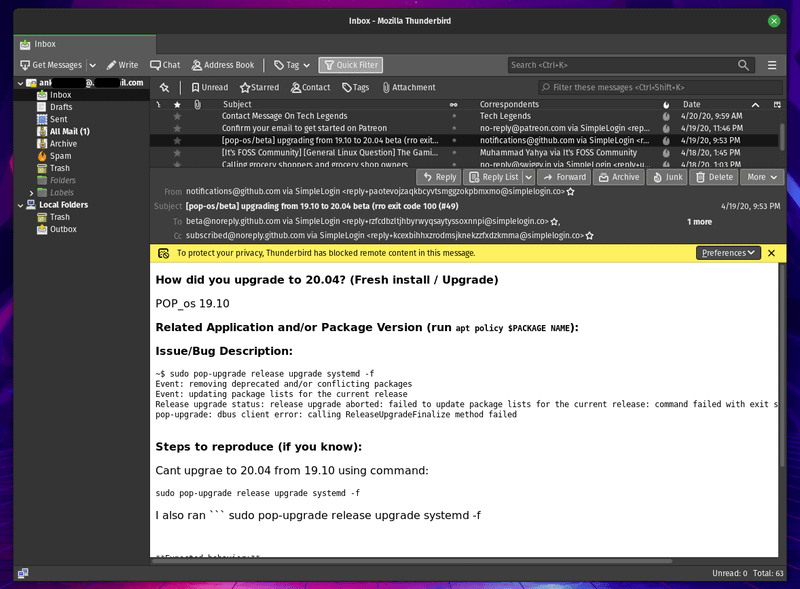
Thunderbird is one of the most popular and oldest open-source email clients from Mozilla Foundation. You can also find it pre-installed on several Linux distributions.
The user interface hasn’t changed much over the years but received some revamps with Thunderbird 91 and later versions, but it is a no-nonsense email client with all the essential features.
Features:
- Contacts Management: Includes an address book that can store detailed information about your contacts. And, includes CardDAV address book support.
- Activity Manager: Recorded interactions between the email provider and Thunderbird.
- Smart Folder: Combined email folders for multiple accounts.
- Privacy & Security: Robust privacy options and phishing protection.
- Search & Filter: Efficient search and quick filter tools for your emails as well as the web.
- Junk Mail Filter: Thunderbird has its spam filter.
- Large File Management: Upload large attachments to outside storage providers without leaving Thunderbird.
- Customization: Thunderbird supports skins for changing the look & feel. Furthermore, there are add-ons for extending Thunderbird features.
How to install Thunderbird in Linux?
Thunderbird should be available through your package manager or software center, regardless of what Linux distribution you are using.
In case you’re using Ubuntu, or any Debian-based distribution, you can simply install it by typing in:
sudo apt install thunderbirdFor any Linux distribution, you can utilize the Flatpak package available. You can refer to our Flatpak guide for help.
2. Evolution

Evolution is an open-source email client by GNOME. It wasn’t as popular as Thunderbird, but now many Linux distributions have considered replacing Thunderbird with Evolution as the pre-installed email client for a better user experience overall.
Features
- Contacts Management: Built-in address book for contacts management.
- Calendar Integration: Calendar integration with your email account.
- Task Manager: Built-in task management tool.
- Notes: Evolution includes a note-taking tool.
- Filters & Folder: Custom virtual folder support for search queries and filters.
- Junk Mail Filter: Includes spam filter powered by SpamAssassin.
- Privacy & Security: Evolution supports both PGP & S/MIME encryption.
- Plugins: Plugins support for various functionalities.
How to install Evolution in Linux?
You can get it right from the software center or through the terminal (for Debian-based distros) by typing in:
sudo apt install evolutionHowever, to get the latest stable version on any Linux distribution, you might want to utilize the Flatpak package available.
3. KMail

Note: KMail is best suited in KDE desktop environment.
KMail is a part of Kontact, a personal information manager, that was developed for and fits nicely with the KDE environment. It can also be used as a standalone email client on other desktop environments as well.
It does install a few tools like KDE Connect along with some other important packages when you install it on a non-KDE desktop system, so if you do not want those, you can manually remove it.
Features:
- Integration: KMail integrates nicely with other Kontact components.
- Search & Filter: Powerful search and filter functionalities for emails.
- Privacy & Security: KMail supports PGP & S/MIME encryption.
- Junk Mail Filter: Integrates with spam filters like SpamAssassin, Bogofilter etc.
How to install Kmail in Linux?
On a KDE-powered system, you should find it pre-installed. For Ubuntu-based distros, you can install it using the terminal:
sudo apt install kmailFor any Linux distribution, you can utilize the Kontact suite available as a Flatpak package and get it installed. This way, you will be able to install Kmail along with some essential tools to make the most out of it.
4. Geary
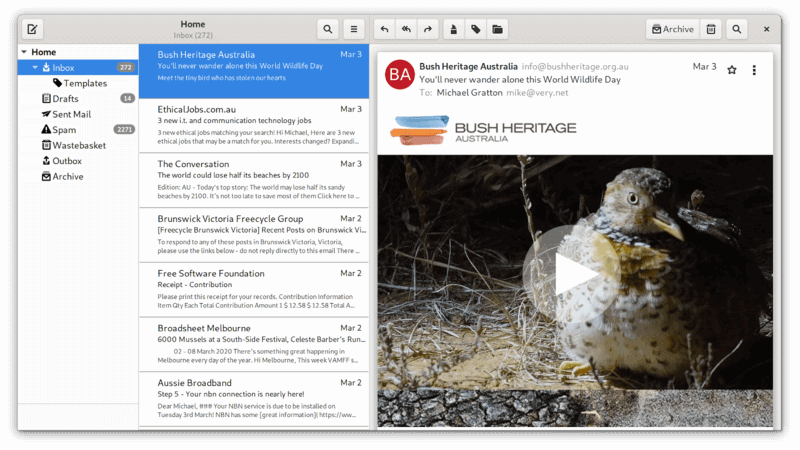
Geary is yet another open-source email client from the GNOME project. It aims to be a simple and fast email client primarily tailored for the GNOME desktop, but you can use it on other desktop environments as well.
Features:
- Interface: Geary is modern looking and lightweight with a simple user-interface.
- Integration & Notification: Geary integrates well with GNOME desktop environment and provides notification for new mail.
Note:
- Geary is best suited in GNOME desktop environment or its variants.
5. Blue Mail
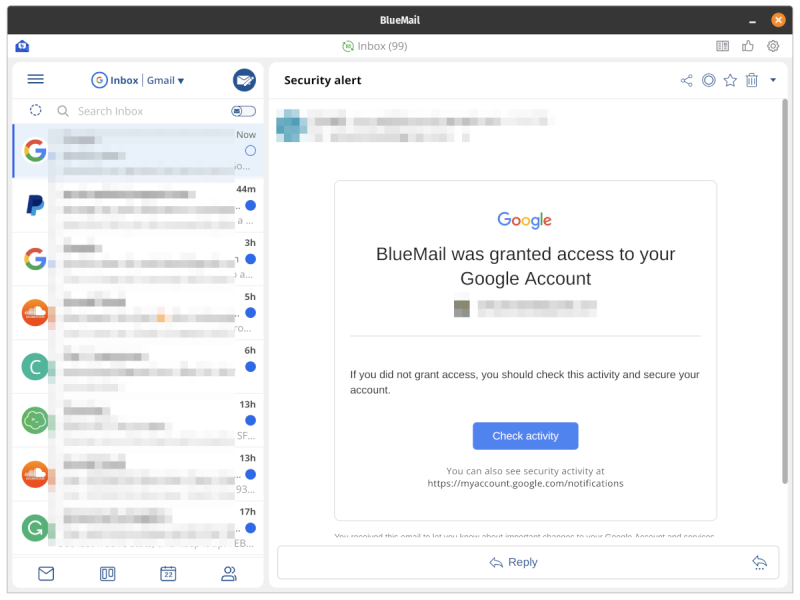
Blue Mail is a proprietary option for Linux users who want a visually appealing email client.
Blue Mail is a quite popular application for Android, so it continues its tradition of offering essential features along with some extras for a premium.
For individuals, it is free. But, if you are a business, you will have to opt for the premium pricing plans.
Features:
- Group mail: You do not need to add members individually, but send emails to a specified group quickly.
- Unified Inbox: You can view all the conversations from every account you add in the desktop client in one place.
- Integrated Calendar: You can check for events, and set calendar reminders from within the mail client.
- Dark theme: If you are regularly working with emails, the dark mode can be a good addition.
- All protocols supported: It supports IMAP, Exchange, ActiveSync, and POP3 as well.
- Other essentials: You can add multiple accounts, use quick filters, can be used offline, and other basic functionalities.
How to Install BlueMail in Linux?
BlueMail is available for Linux as a Snap, DEB package, and RPM package. The snap package should be suitable for every Linux distribution.
You will not find it listed in your software center or the repositories unless you have snap integrated.
6. Claws Mail
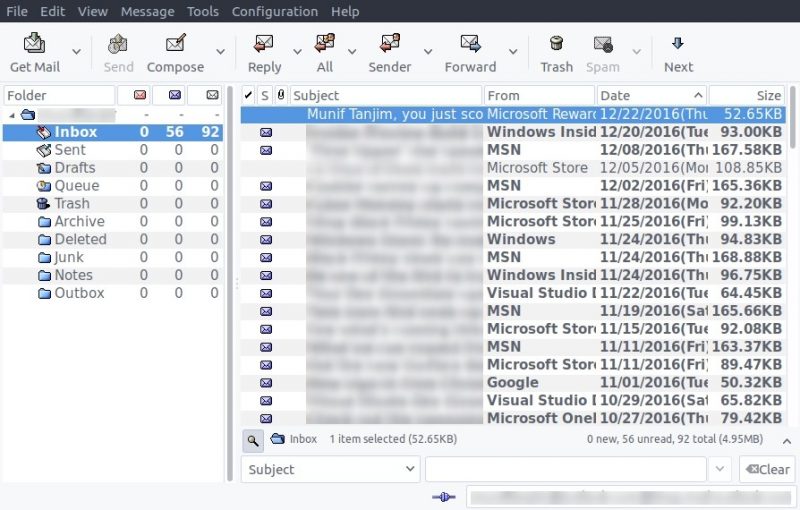
Note: Needs manual configuration for email accounts.
Claws Mail is a lightweight email client using a GTK+ interface that focuses on giving a familiar user experience to popular email clients while providing some extra functionalities like RSS aggregator.
Features:
- Contacts Management: It has basic address book functionality.
- Plugins: Claws Mail supports plugins for extending its features.
7. Mutt
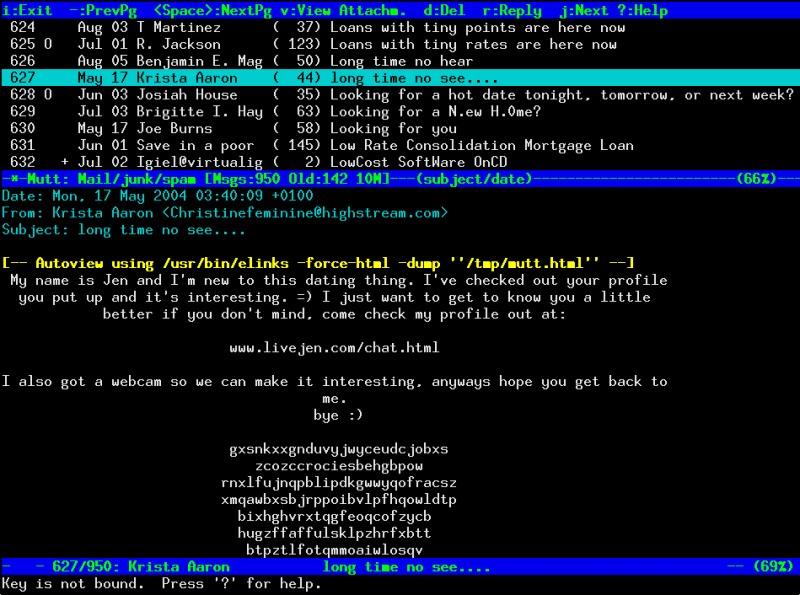
If you are an avid terminal fan, Mutt is a text-based email client.
Features:
- Interface: Mutt runs entirely in your terminal windows with a text-based user-interface.
- Security: It supports PGP and MIME.
- Customization: Highly customizable with keybindings and macros support.
- Searching: Regular Expression support for searching emails.
Note:
- If you are a beginner user, you might find it difficult to configure Mutt.
8. Mailspring (Previously known as Nylas Mail)
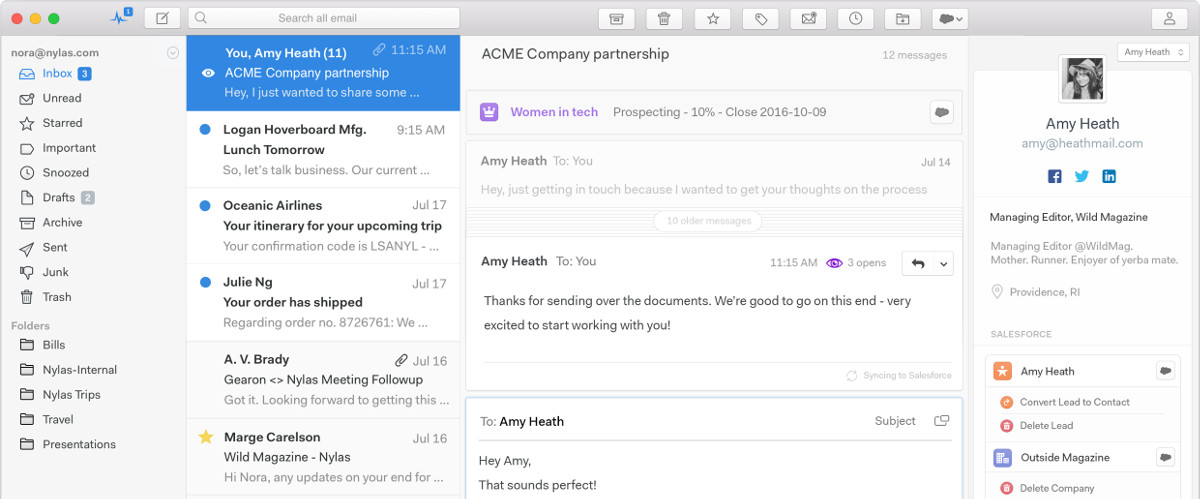
Mailspring, formerly known as Nylas Mail or Nylas N1 is a next-generation email app built with open web technologies. It has a really modern and slick user interface.
Even though it offers many features, most of them are limited to a premium subscription.
Do note that many readers warn of terrible support by the Mailspring team, so feel free to give it a try if you do not mind that.
Features:
- Unified Inbox: Mailspring supports all the major email providers. So, you can manage all your accounts from a single interface.
- Contacts Management: Contacts with enriched profiles containing bio, social links, location info and more.
- Calendar Integration: Mailspring will check your calendar and let you book meetings at a suitable time when you are free or send your availability schedule to others.
- Snooze: Snooze emails with lower-priorities for dealing with them later.
- Scheduler: You can schedule your email to be sent at a suitable time when most people open their emails.
- Privacy & Security: Mailspring leverages the PGP encryption for ensuring privacy and security.
- Mail Merge: You can send customized emails to a large number of people with a personal touch, e.g. you will type you mail once and Mailspring will enter each people’s name where you want it.
- Quick Reply Templates: You can create custom templates for various situations so that you can edit them and send replies quickly.
- Analytics & Tracking: It provides analytics features and tracking information, such as – email read notification, click counts of your sent links.
- Translator: Built-in translation support for various languages.
- Customization: All the things above are just things that come out-of-the-box. Mailspring is customizable and extensible to its core. You can customize its look however you see fit by tweaking its CSS stylesheet or extend its features with various extensions available. Or better yet, if you know JavaScript, you can even build one yourself!
Hiri [Possibly unmtaintained]
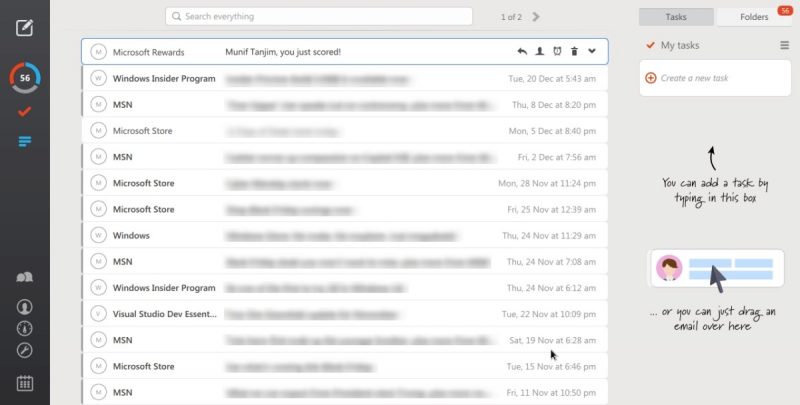
Despite being a promising paid app, it seems that the Hiri developers have become unresponsive. We don’t recommend using it anymore.
Hiri is an email client specifically created for Microsoft and Exchange email services. Read the Hiri review to know its features in detail.
Features:
- Dashboard: Hiri presents a personalized dashboard with various information.
- Calendar Integration: It has a built-in calendar for managing your schedule.
- Task Manager: It has an integrated task manager for efficiently managing your tasks.
- 4 Ds Workflow: Hiri provides a Delegate-Delete-Delay-Drag workflow. These are the main options you can apply to an email – forward it to another person, delete it, snooze it for checking later or drag it to the task manager.
- Email Filter Section: It introduces two filters – Actionable and FYI. If the email was primarily sent to you it goes to your actionable section. If you were on the CC list, it will go to the FYI section.
- Email Rating: You can rate received emails and the sender can see the anonymous rating on their dashboard.
- Enterprise ready: Hiri is focused on big scale enterprise usage.
Notes:
- Hiri is free for first seven days only.
- It only works with Microsoft and Exchange email services.
- Hiri is closed sourced.
Sylpheed (No more support for Linux)

Note: Needs manual configuration for email accounts except Gmail.
Sylpheed was a lightweight email client that used GTK+ interface. It offered more or less the same key features but stopped developing for Linux
Features:
- Interface: Sylpheed has a simple user-interface.
- Speed: Sylpheed is written in pure C language. So, it can handle a large amount of data without lagging.
- Search & Filter: It has powerful and advanced search and filter functionalities.
- Junk Mail Filter: It supports Bogofilter, bsfilter etc. for spam filtering.
- Privacy & Security: It includes support for GPG encryption.
Which one do you think is the best email client for Linux?
Mailspring can be a good option if you’re willing to pay a premium (if we don’t consider their potentially bad customer support).
If you want to stick to open-source options, Evolution, and Thunderbird are still the best bet, no matter what.
In either case, if you want a change and have had enough with usual email clients, you should try the ones you’ve never tested and then make a decision.
Do you use desktop email clients or prefer the web browser? If you do, which is the best email client for Linux in your opinion?

